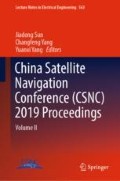Abstract
The modernized global navigation satellite system (GNSS) provides the open service (OS) signal and authorized service (AS) signal for users. Each service signal includes a data component and a pilot component. All the signal components need to be combined into a composite signal for broadcast. To verify whether the transmitted signal generated by satellite payload can meet the design requirements, the signal in space is collected by high gain antenna, and the signal quality is evaluated. However, the spreading spectrum code sequences of AS signal are unknown. In order to evaluate the signal quality of AS signal, the code sequences of AS signal have to be recovered. The current methods are based on the following assumptions: the expression of the constant envelope composite signal or the power/phase relationship of AS signal is known. Nevertheless, the above assumptions may be not satisfied. This paper studies the code sequences estimation method when the expression of the constant envelope composite signal and the power/phase relationship of AS signal are unknown. The proposed method treats the code sequences as the optimized variables. The utility function to obtain the maximum cross-correlation value is exploited. The optimization problem is solved by the binary genetic algorithm. On this basic, the separation method of AS signal component is presented. The correlation function of AS signal is obtained, and the correlation characteristics of AS signal component are evaluated. The performance of the proposed method is verified by the theoretical analysis and numerical simulation. Finally, based on the proposed method, we evaluate the signal quality of Galileo E1 signal collected by a 6 m antenna, which shows the effectiveness of the proposed method.
Access this chapter
Tax calculation will be finalised at checkout
Purchases are for personal use only
References
Christie JRI, Bentley PB, Ciboci JW, Gellrich CA, Gondek JM, Knoth BK, Ressler MB, Oetzel GN (2004) GPS signal quality monitoring system. In: ION GNSS 17th international technical meeting of the satellite division, Long Beach, CA, 21–24 September 2004, pp 2239–2245
Graf S, Gunther C (2006) Analysis of GIOVE-A L1-signals. In: ION GNSS 19th international technical meeting of the satellite division, Fort Worth, TX, 26–29 September 2006, pp 1560–1566
He C, Guo J, Lu X, Lu J (2015) Generation mechanisms of GNSS navigation signal distortions and influence on ranging performance. Syst Eng Electron 37(7):P1611–P1620
European GNSS (2016) (Galileo) Open Service Signal-In-Space Interface Control Document, Issue 1.3, European Union
Betz JW (2013) Something old, something new. InsideGNSS July/August, 34–42
Yan T, Tang Z, Wei J, Qu B, Zhou Z (2015) A quasi-constant envelope multiplexing technique for GNSS signals. J Navig 68(4):791–808
(2018) NAVSTAR GPS Space Segment/USER Segment L1C Interface (IS-GPS-800E)
Betz JW (2000) Design and performance of code tracking for the GPS M code signal. In: Proceedings of the 13th international technical meeting of the satellite division of the institute of navigation (ION GPS 2000), Salt Lake City, UT, September 2000, pp 2140–2150
Turner M, Richardson A, Haddon J, Batiste M, Aguado E, Wales B, Dumville M, Bowden R, Togneri P (2015) Galileo public regulated services (PRS) with limited key distribution. ION GNSS+ 2015, pp 3397–3404
Xiao W, Liu W, Mou W, Yong L, Sun G (2018) Research into a recovery method of GNSS authorized service signal component. IEEE Access 6:27651–27658
Kang L, Lu X, Wang X, He C, Rao Y, Yang D (2018) Authorized signals quality assessment on GPS L1. J Electron Inf Technol 40(4):905–910
Thoelert S, Hauschild A, Steigenberger P, Langley RB, Antreich F (2018) GPS IIR-M L1 transmit power redistribution: analysis of GNSS receiver and high-gain antenna data. Navig: J Inst Navig 65:423–430
Ren Z, San Y (2006) Improved adaptive genetic algorithm and its application research in parameter identification. J Syst Simul 18(1):41–43, 66
Hein GW, Avila-Rodriguez JA, Ries L, Lestarquit L, Issler JL, Godet J, Pratt T (2005) A candidate for the Galileo L1 OS optimized signal. In: Proceedings of the 18th international technical meeting of the satellite division (ION GNSS 2005), Long Beach, CA, September 2005, pp 833–845
Yang D, Lu X, Wang X (2017) Analysis and evaluation of Galileo E1 signal. J Time Freq 40(3):178–192
Acknowledgment
This work is supported by National Natural Science Foundation of China (Grant 11803023).
Author information
Authors and Affiliations
Corresponding author
Editor information
Editors and Affiliations
Rights and permissions
Copyright information
© 2019 Springer Nature Singapore Pte Ltd.
About this paper
Cite this paper
Yan, T., Wang, Y., Wang, G., Qu, B., Lei, W., Meng, Y. (2019). Separation and Evaluation Method of GNSS Authorized Service Signals. In: Sun, J., Yang, C., Yang, Y. (eds) China Satellite Navigation Conference (CSNC) 2019 Proceedings. CSNC 2019. Lecture Notes in Electrical Engineering, vol 563. Springer, Singapore. https://doi.org/10.1007/978-981-13-7759-4_30
Download citation
DOI: https://doi.org/10.1007/978-981-13-7759-4_30
Published:
Publisher Name: Springer, Singapore
Print ISBN: 978-981-13-7758-7
Online ISBN: 978-981-13-7759-4
eBook Packages: EngineeringEngineering (R0)

